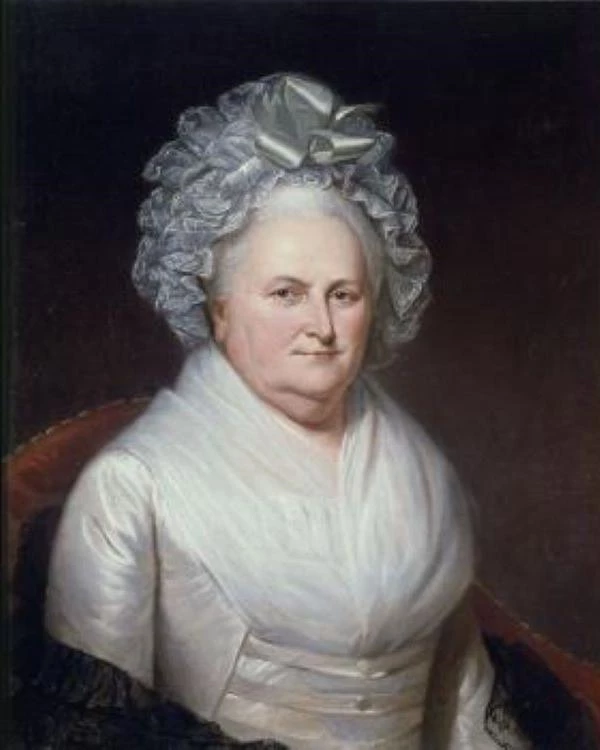Last updated: May 6, 2025
Person
Martha Washington

Independence National Historical Park Museum Collection (INDE 14172)
A woman of strength, resilience, and grace, Martha Washington played a crucial role in shaping the early history of the United States. As the nation's first First Lady, she set a precedent for the role and offered support to her husband during the turbulent years of the American Revolution and the founding of the new republic.
Early Life and First Marriage
Martha Dandridge was born on June 2, 1731, at Chestnut Grove Plantation in New Kent County, Virginia to John Dandridge (1700-1756), a successful planter who enslaved between 15 and 20 people, and Frances Jones (1710-1785), the daughter of a member of the Virginia House of Burgesses. As the eldest daughter in a respected family, Martha was educated in the domestic skills expected of women of her status, including household management, needlework, and social etiquette. While formal education was limited for women of her time, Martha likely received instruction in reading, writing, and basic arithmetic.
In 1750, at the age of 18, she married Daniel Parke Custis, a wealthy and much older planter. The couple lived at the Custis family estate, White House Plantation, and had four children together: Daniel, Frances, John "Jacky," and Martha "Patsy." Tragically, only two of the children, Jacky and Patsy, survived past early childhood. Daniel Parke Custis died unexpectedly in 1757, leaving Martha a widow at just 26 years old. She and her children inherited her late husband’s property, which included more than 17,500 acres of land, nearly 300 enslaved people, and financial resources, making her one of the wealthiest women in Virginia. While a widow, she managed the estate and its business interests.
Marriage to George Washington
In 1758, Martha met George Washington, a rising military officer and landowner. The two shared a similar social standing and quickly formed a bond. They were married on January 6, 1759, at her estate. The union brought George not only personal fulfillment but also financial security, as Martha’s wealth helped bolster his status.
The couple settled at Mount Vernon, George’s plantation in Virginia. Though they had no children of their own, they raised Martha’s two surviving children from her first marriage. Tragically, Patsy suffered from epilepsy and died in 1773, leaving Jacky as their sole surviving child. Jacky, however, died in 1781 at Yorktown of camp fever, further deepening Martha’s personal losses.
The Revolutionary War
As the American Revolution unfolded, Martha Washington became an essential source of support for her husband. While George commanded the Continental Army, Martha spent significant time at the army’s winter encampments, starting with Cambridge Headquarters in the winter of 1775-76 and notably at Valley Forge in the winter of 1777-78. She entertained visiting dignitaries and wives of officers, provided comfort to the troops, organized supplies, and uplifted morale.
Like other prominent women, such as Abigail Adams, Martha Washington worked to organize aid for soldiers. She led efforts to provide clothing and supplies, often using her own resources. These efforts helped sustain the Continental Army through harsh winters and contributed to the war effort in a vital, though often unrecognized, manner.
The First Lady of the United States
With the war won and the new nation established, George Washington was unanimously elected as the first President of the United States in 1789. Though reluctant to assume the role, Martha joined him in New York City, the first capital, and later in Philadelphia, the nation’s second capital.
As the first presidential spouse, Martha Washington defined the early role of the First Lady. She hosted weekly receptions, known as “levees,” where she entertained dignitaries, diplomats, and citizens. These events helped establish social norms for the new republic, adapting European courtly traditions with a distinct American style. Though Martha saw her role as primarily social, she also influenced political discourse through her connections and correspondence.
Despite her status, Martha Washington found the constraints of public life difficult. She often expressed a longing for the quiet life at Mount Vernon, writing to friends about her preference for private life over political obligations.
Later Years and Legacy
After two presidential terms, the Washingtons retired to Mount Vernon in 1797. The couple enjoyed a brief period of peace before George’s death in December 1799. Martha was devastated by the loss. She freed 123 of the people her husband enslaved on January 1, 1801, ahead of his wishes. However, she continued to enslave other people, including those she inherited from her first husband, until the end of her life.
Martha spent her remaining time at Mount Vernon, living a quiet and private life. She died on May 22, 1802, at the age of 70. She was buried alongside George at Mount Vernon, where their legacy continues to be honored.
Historical Significance
Martha Washington’s support of George Washington during the Revolutionary War and presidency played a critical role in shaping the nation’s early leadership. Yet, beyond her public role, Martha Washington’s life reflects the experiences of women in 1700s, particularly those of wealth and status. Her management of plantations, engagement in political discourse, and navigation of personal losses provide insight into one woman’s life in early America.
Today, Martha Washington is remembered as a foundational figure in American history, albeit complicated by her legacy of support for the freedom of some, while enslaving others. Her image has appeared on currency, postage stamps, and various historical commemorations. Her strength, resilience, and dedication to her country continue to inspire generations of Americans.
Martha Washington may not have held political office, but her legacy remains deeply interwoven with the establishment of the United States of America.
